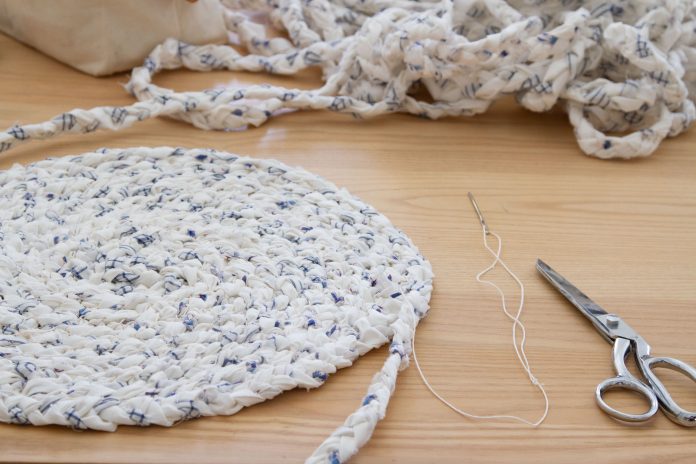Creating a 4 strand braided rug transforms old fabric scraps into a durable, customizable floor covering that adds warmth and character to any room. This traditional craft technique produces a thicker braid than the common three-strand method, making the rug-making process faster while creating a more substantial finished product.
A 4 strand braided rug requires four fabric strips of equal width that are interwoven using a specific over-under pattern, then coiled and secured to form the final rug shape. The technique allows crafters to repurpose old sheets, t-shirts, or other cotton materials into functional home decor.
This step-by-step guide covers everything needed to create a professional-looking braided rug, from selecting and preparing fabric materials to mastering the four-strand braiding technique and assembling the final piece. The process requires minimal tools and no advanced sewing skills, making it accessible for beginners while producing results that rival store-bought options.
Preparing Materials for a 4 Strand Braided Rug
Proper material preparation forms the foundation of a successful 4 strand braided rug project. The process involves selecting appropriate fabrics, cutting uniform strips, and organizing materials for efficient braiding.
Choosing Fabrics and Colors
Fabric selection determines the durability and appearance of a 4 strand braided rug. Cotton and wool fabrics work best because they provide strength and flexibility during the braiding process.
Heavy-weight cotton fabrics like denim, canvas, and upholstery materials create sturdy rugs. Wool blankets and sweaters offer excellent resilience and natural stain resistance.
Recommended fabric weights:
- Cotton: 8-12 oz per square yard
- Wool: Medium to heavy weight
- Denim: 12-14 oz per square yard
Color coordination requires planning the overall design before cutting begins. Traditional braided rugs use three complementary colors, but 4 strand patterns allow for four distinct color groups.
Choose colors that complement the room’s existing decor. Dark colors hide dirt better in high-traffic areas. Light colors make small spaces appear larger.
Test fabric combinations by laying strips side by side before cutting. Ensure adequate contrast between colors for visible pattern definition.
Cutting and Joining Fabric Strips
Fabric strips for 4 strand braided rugs require consistent width for uniform results. Cut strips 1.5 to 2 inches wide for most fabric weights.
Mark cutting lines with a ruler and fabric chalk before cutting. Use sharp fabric scissors or a rotary cutter for clean, straight edges.
Strip width guidelines:
- Lightweight fabrics: 2 inches
- Medium weight fabrics: 1.75 inches
- Heavy weight fabrics: 1.5 inches
Join fabric strips by overlapping ends 1 inch and sewing with a 1/4-inch seam allowance. Trim excess fabric close to the seam to reduce bulk.
Create continuous lengths of each color by joining multiple strips. Plan for approximately 8-10 yards of each color for a small 2×3 foot rug.
Press seams flat before folding strips. Fold each strip lengthwise with raw edges inside to create neat, finished edges for braiding.
Organizing and Sorting Fabric Strips
Organization streamlines the braiding process and prevents tangling of fabric strips. Sort prepared strips by color into separate containers or baskets.
Wind each color group into loose coils to prevent kinking. Secure coils with rubber bands or clips at multiple points along the length.
Label each color group if using similar shades. This prevents confusion during the braiding process when working with multiple strands.
Organization system:
- Container 1: Primary color strips
- Container 2: Secondary color strips
- Container 3: Accent color strips
- Container 4: Border color strips
Keep containers within easy reach of the work area. Position them in the order they will be used in the 4 strand braided rug pattern.
Calculate total yardage needed before beginning. Multiply the finished rug’s square footage by 3.5 to determine approximate fabric strip requirements.
Braiding and Assembling the Rug
The four-strand braiding technique creates a wider, more substantial braid than traditional three-strand methods, while proper assembly ensures the rug lies flat and maintains its shape over time.
Starting the Four-Strand Braid
Begin by selecting four fabric strips in your desired color sequence. Knot the strips together at one end, leaving about 2 inches of tail beyond the knot.
Arrange the strips in order from left to right. Number them mentally as 1, 2, 3, and 4 for easier tracking during the braiding process.
Take strip 1 and cross it over strips 2 and 3, positioning it between strips 3 and 4. Strip 1 now becomes the third position.
Move strip 4 under the strip that was formerly strip 1, then over the next strip to the left. This creates the distinctive four-strand pattern.
Continue this sequence: the leftmost strip always goes over two strips to the right, then the rightmost strip goes under one and over one to the left. Keep tension consistent throughout the process.
The braid should measure approximately 1 to 1.5 inches wide when properly executed. Adjust tension if the braid appears too loose or too tight.
Adding New Strips While Braiding
Plan strip additions before the current strips become too short to handle comfortably. Leave at least 6 inches of working length before adding new material.
Choose a stopping point where the braid feels secure. Adding strips mid-sequence can disrupt the pattern and create weak spots in the finished rug.
Method 1: Overlapping Technique
- Place the new strip alongside the ending strip
- Overlap by 3-4 inches
- Continue braiding, treating both strips as one
Method 2: Sewing Method
- Sew the new strip to the old strip end-to-end
- Trim excess fabric to reduce bulk
- Resume braiding immediately
Stagger the addition points so all four strips are not joined simultaneously. This prevents thick spots that can create bumps in the finished braided rag rug.
Test the join by gently tugging the braid. The connection should feel secure without visible gaps or loose sections.
Techniques for Attaching the Braid to the Rug
Spiral Method
Start from the center and work outward in a continuous spiral. This creates an oval or round shape depending on the starting coil size.
Pin the braid center in place on your work surface. Begin coiling the braid around this center point, keeping edges tight against each other.
Traditional Sewing Attachment
Use heavy-duty thread in a color that matches your darkest fabric strips. A curved upholstery needle works best for this technique.
Stitch through the edge of each coil, catching both the current row and the previous row. Keep stitches small and tight to prevent gaps from forming.
No-Sew Lacing Method
Cut small slits in the braid edges approximately every 2 inches. Thread a fabric strip through these slits to connect adjacent rows.
This method works particularly well for 4 strand braided rug projects using heavy fabrics that resist traditional sewing methods.
Securing and Finishing the Rug
Taper the final section by gradually reducing strip width. Cut each strip to different lengths, creating a natural-looking end point.
Braid the tapered strips until only 2-3 inches of material remain. Secure this end with a tight knot or heavy-duty thread.
Tuck the finished end under the rug’s outer edge. Stitch it firmly in place using matching thread, ensuring the attachment point remains invisible from above.
Edge Finishing Options:
- Binding tape: Apply fabric binding around the perimeter
- Zigzag stitching: Machine stitch around the outer edge
- Hand whipstitching: Secure loose edges manually
Check the completed rug for any loose sections or protruding threads. Trim excess material and reinforce weak attachment points as needed.
Place the finished rug on a flat surface and allow it to settle for 24 hours before regular use.


